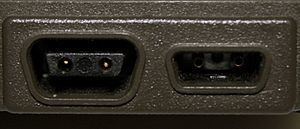Type Peripheral data bus Designed 1980s | External yes | |
 | ||
Hhc 2015 virtual hp il and related topics update
The HP-IL (Hewlett-Packard Interface Loop), was a short-range interconnection bus or network introduced by Hewlett-Packard in the early 1980s. It enabled several devices such as printers, floppy disk drives, tape readers, etc. to be connected to programmable calculators such as the HP-41C, HP-71B and HP-75C/D, the 80-series and HP-110 computers, as well as generic ISA bus based PCs.
Contents
- Hhc 2015 virtual hp il and related topics update
- Hp 41cx loading program from hp il cassette drive and card reader
- Principles
- Applications
- HP Calculator Applications
- HP IL to HP IB interfacing
- Controllers
- Interfaces
- Peripherals
- Test instruments
- Software
- Third party
- References
Hp 41cx loading program from hp il cassette drive and card reader
Principles
As its name implies, the HP-IL cable formed a loop: the cable originated in the HP-IL extension module, ran through all connected devices, then came back to the module. Every device on the bus has a ring-in and a ring-out connector, either on pigtails or built in. HP used a proprietary two-pin connector design with polarizing "D"-shaped shells. HP-IL cables can be interconnected without further adapters to extend their length.
The IL used a form of Token passing protocol for media access control. Each device on loop receives a sequentially assigned address automatically, from 1 up to 30. On the bus, devices could act as controllers (the calculators/computers) or slaves (the peripherals). Certain controllers like the HP-71 module or the HP82973A ISA interface could act as slaves as well, enabling a small network of calculators to be set up.
In the loop, there is one controller, one listener and one talker device at any time, others are inactive. The talker is the device that is sending information to the loop, and the listener is that one that receives information from the loop. The controller is the device that commands devices to talk and listen. In calculator-based systems (e.g. using the HP-41C), the calculator is always the active controller.
Applications
Hewlett-Packard developed a range of devices to be connected to the HP-IL, mostly peripherals such as printers and storage devices for calculators. Through the 82169A HP-IL/HP-IB Interface, HP-IL controllers could be connected to instruments with an HP-IB (aka GPIB or IEEE-488) interface, or vice versa. There were also plans to make test equipment with IL interfaces, but apart from the somewhat popular 3468A multimeter, only a few devices were introduced before HP-IL itself became obsolete.
In addition to the HP-IB interface, HP also sold RS-232 and general-purpose parallel I/O interfaces as well as a prototype kit to create custom interfaces.
HP Calculator Applications
Several HP calculators were offered with HP-IL interfaces. In the HP-75C/D it was built in, in others such as the HP-71 and HP-41, plug in interface modules were available (such as the HP82160A for the HP-41). Popular uses for the HP-IL on the calculators included printing (using the HP 82162A thermal printer) and cassette file storage (through the HP 82161A digital cassette drive). For ease of use, the calculators supported automatic I/O address assignment ("AUTOIO"), where printer or mass storage commands are directed to the first available device of the appropriate type. Where multiple devices per type were present, a manual ("MANIO") assignment mode could be used.
HP-IL to HP-IB interfacing
Through the 82169A interface converter, even small calculators could be used to control a number of devices on a standard HP-IB (GPIB, IEEE-488) bus, an interface in wide use for test and measurement equipment. The converter can operate in either of two modes, Translator or Mailbox. Translator mode is adequate for systems where only one controller is present (typically a calculator on HP-IL), while Mailbox mode applies when there are separate controllers present on both buses.
In Translator mode with an HP-IL controller, the default addressing mode is to connect the converter as the last device in the HP-IL loop, to set its own HP-IB address higher than the number of devices on the HP-IL loop, and to set the addresses of devices to be addressed on the HP-IB side must be higher than the converter's address. Deviating from this scheme requires manual control of addressing.
In Mailbox mode, the controllers on either side can place a message into the converter's buffer memory, for the other side to retrieve from that memory.
